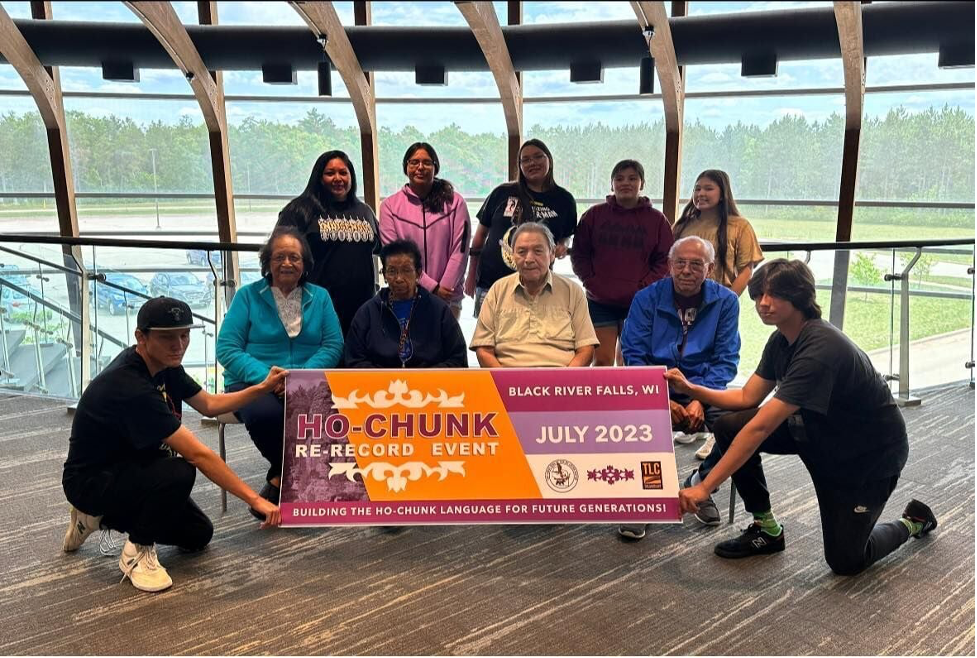Ho-Chunk seek to preserve endangered language through recordings of elders
Jonathan Shipley | Milwaukee Journal Sentinel | August 1, 2023

Tribal members of the Ho-Chunk Nation recently recorded words, phrases and sentences to preserve the endangered language.
Elder members of the Ho-Chunk Nation are some of the last vessels of the Ho-Chunk language, whose known speakers were last estimated at fewer than 40 individuals.
Once it’s lost, a vital part of the Nation’s identity risks being lost as well.
“The history, the prayers, the poetry, the art, all of that is expressed in a very unique Ho-Chunk worldview in the language,” said Wilhelm Meya, chairman and CEO of the Language Conservancy, which seeks to protect and revive endangered Indigenous languages. “It’s a language that’s tens of thousands of years old, passed down generations. It represents one of the oldest languages in North America. It represents Wisconsin.”
In hopes of preserving Hoocak, as the language is known, and making it available for future generations, the Nation and the Language Conservancy recently brought several elder members together in Black River Falls, the administrative center for the Ho-Chunk Nation, to record samples of the language.
The recordings are part of a decades long effort by the Ho-Chunk to develop learning materials to sustain the language. The Nation has developed speakers in an “Eminent Speakers” program in which members of the community teach the language, assist with curriculum development, and work with apprentices to preserve the language.
Some Eminent Speakers offer community classes, providing people of all ages and backgrounds an opportunity to learn the language.
There are other language enrichment opportunities available, as well. Baraboo High School, for instance, began offering Hoocąk in the spring semester of the 2018-19 academic year.
In 2022, an online and mobile dictionary was created, offering more accessibility to the language than ever before. It includes nearly 12,000 entries and over 9,000 example sentences.
“It opened the door to many potential new learners,” Meya said.
With many of the language’s remaining speakers now over 75, Nation officials thought it vital that they record as much of them as they could, capturing voices and dialects.
The new recordings will be uploaded to the online dictionary and added to the app that students of the language can download and use as a resource. The Ho-Chunk Nation has more than 7,800 members. According to one measure of language endangerment known as the Expanded Graded Intergenerational Disruption Scale, the Ho-Chunk language falls under the level of “moribund,” a level that teeters on extinction.
Under that designation, “the only remaining active users of the language are members of the grandparent generation or older.”
At one time, there were more than 300 distinct Indigenous languages spoken in the United States, according to the Administration for Native Americans. Approximately 175 remain today. Without restoration efforts, experts estimate that by the year 2050 only 20 languages will still be spoken.
In 2009, Bemidji State University surveyed the Ojibwe (Chippewa) and found fewer than 1,000 members who had the Ojibwe language as a first language. There are approximately 320,000 Ojibwe tribal members.
In 2013, as part of a UW-Stevens Point project, just six or seven people were found to be conversant in the Menominee language. In 2021, Bodwéwadmimwen, the language of the Potawatomi, had only eight people who learned it as their first language.
At the Black River Falls event, native Ho-Chunk speakers recorded around 1,000 phrases and sentences. The recordings will be used in the development of an upcoming e-learning platform called Hoocąk Woiperes.
“We want to make sure that the language is continued on for generations into the future,” Meya said, “so Ho-Chunk people can continue to be Ho-Chunk and express their culture and their identity in positive ways that contribute to the larger world in a meaningful way.”

